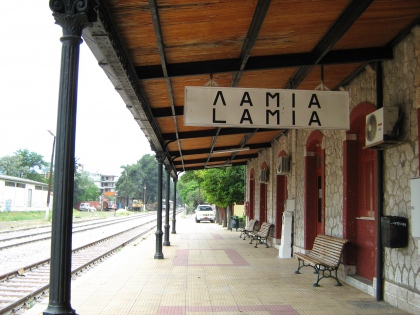
Dilyana Ivanova
Central Greece is slightly underestimated by tourists, but what follows is an idea of how to spend a pleasant weekend, without being disturbed by crowds of tourists.
Lamia is situated in Central Greece, on the main road between Salonika and Athens. According to the 2001 census, population of the city is 50 551 people. With its own University, airport, and good sporting facilities, Lamia is the perfect center of continental Greece. The railway system has two stations around the city. One of them is rather old and not so frequently used, except for very busy days. The new one on the other hand is 5 km. away from the city center, and is a crucial junction for the Athens – Salonika rail line. The coach station is very near to the center, and transportation is provided daily – even on holidays.
Ever since the medieval period, starting from the eight Ecumenical in 869 AD, Lamia has been called Zetounion, with the name staying in use until the beginning of the XIX century. One of the theories regarding the name suggests that the root is Arabic (Zeitun – olive oil), or from the Slavic word sitonion (land above the river).
Lamia captures people’s attention with its tiny squares and visitors stop to make pictures rather often, truly enchanted by the peacefulness of the town and it’s cheerful population. You can regularly stop at one of the lovely bakeries around town, but be prepared to try everything – sweets here are made using ancient recipes, containing even traces of pepper and orange rind jelly. But what Lamia is mostly famous for is its grilled lamb. Especially during holidays, it’s a family tradition to prepare a full table of meals and one can stand a few miles away from the town and still smell the charming “scent” of the seasonings, the bread and the lamb.
Historic landmarks in Lamia include the archaeological museum and the two ancient castles. In the museum, visitors can find artifacts dating back to the fifth millennium B.C. There, one can also here the story of how apostles Paulos and Lukas visited Lamia on their way from Corinth to Macedonia. Citizens of the region are thought to be one of the first preachers of Christianity, evidence dating back to 52 AD. It is also worth visiting the Folklore museum and some of the plays at the Municipal Theater.
On the rocky hill above the town is where an ancient castle is situated, while on the other side of the hill one can visit the second of the ancient castles, dating back to the beginning of the XVIII century, and subsequently turned into the Church of Agios Loukas.
 The first epic battle at the Thermopylae, where the king of the Spartans Leonidas I died, took place somewhere near the Lamia of today. The warm mineral springs that gave Thermopylae its name can still be found at the feet of the hills near the tall cliffs. Crossing the Balkan Peninsula from North to South and back, around the East coast is impossible without using the passage. That is why it has been the area of many battles during the years.
The first epic battle at the Thermopylae, where the king of the Spartans Leonidas I died, took place somewhere near the Lamia of today. The warm mineral springs that gave Thermopylae its name can still be found at the feet of the hills near the tall cliffs. Crossing the Balkan Peninsula from North to South and back, around the East coast is impossible without using the passage. That is why it has been the area of many battles during the years.
At this exact place, in 481 B.C., the war between the Greeks and Persians started. On the side of the Greeks, Leonidas I led a small army of Spartans against the significantly multifold Persians, lead by their eminent leader Xerxes. Leonidas’ name stands until today for unmatched bravery, strength, and self-sacrifice. Even though he lost the doomed battle, his glory spreads and grows with time.
On the already mentioned hill where the monument is, you can also find Simonides of Ceos’ epitaph, carved in stone and placed on the top.